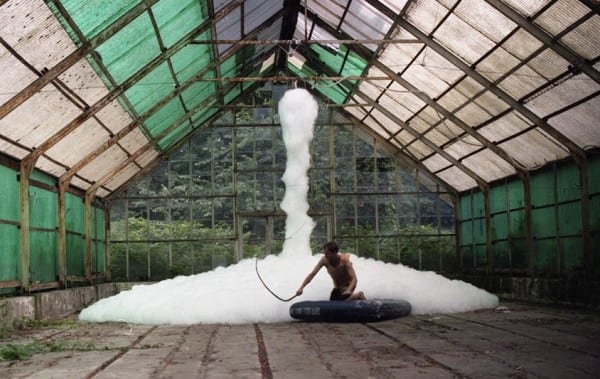


Anna Molska
Born in 1983, in Prudnik (Poland), Anna Molska lives and works in Warsaw.
She graduated in 2008 from the Warsaw Fine Arts School.
Statement
In her films, videos and installations, Anna Molska shows an interest in the concepts of play and theatricality, as well as revolutionary utopias and notably Soviet, avant-garde ideals.
Hecatomb, 2011
16 mm film transferred in video
colors, sound, 9’57’’
Edition 1/3
Acquisition in 2012
A silent film, Hecatomb focuses on a character evolving in an abandoned place. Dressed strangely in a kind of supple armour with an oversized pair of shorts, a young man moves about in a greenhouse surrounded by nature. Several actions succeed each other: he walks about the space in which he finds himself; he handles a large whip; he lies down on an inflatable mattress placed on the ground. Suddenly, foam begins to fall from the ceiling until it fills the place. The adolescent waits and reacts to what is happening. In turn, he explores, sits down, and thrashes about. Confined like a wild animal in a cage, he is the actor in a performance captured on camera, the different camera shots (wide/close-up, frontal/shot from above, etc.) detail his successive physical states, which in turn translate the many emotional states he goes through. Rather than a well thought out narrative, the film creates an atmosphere with abstract symbolism, touching on the characteristics of youth, its rituals and excesses. Although he is awake, the spectator is confronted with a dream image, which is both precise and unreal at the same time, close to the stage of sleep onset latency. Invited to a silent meditation, the spectator is left waiting for an end which never comes since the film runs in a continuous loop. No explanation, nor single possible reading or interpretation is given. Although the action appears to develop with a unity of character, space and time, certain details and unusual features interrupt this homogeneity. For example, other naked bodies make a brief appearance in this place, almost like a subliminal image, in a sequence filmed with a colour filter. Closed and open at the same time, the place conveys a dichotomy between interiority and exteriority, nature and culture, emptiness and fullness. Appearing to have the possibility to escape into the vegetation, the young man actually returns to his starting point. Suspended and extended, the endless time that develops allows the drama to explode, like the eruption of the foam. In the end, aspects of the camerawork produce a “magnifying glass effect” and exacerbate the growing and palpable sense of tension which permeates every minute of the film.